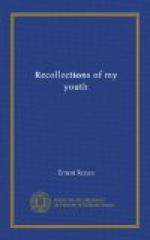He might, perhaps, create a scandal. All the principal inhabitants were assembled in the cell, with his stark black corpse in their midst, when one of them made the following sensible suggestion: “We never could understand him when he was alive; it was easier to trace the flight of the swallow than to guess at his thoughts. Now that he is dead, let him still follow his own fancy. We will cut down a few trees, make a waggon of them and harness four oxen to it. Then he can let them take him to the place where he wishes to be buried.” This was done, and the body of the saint deposited on the vehicle. The oxen, guided by the invisible hand of Ronan, went in a straight line into the thick of the forest, the trees bent or broke beneath their steps with an awful crackling sound. The waggon stopped in the centre of the forest, just where the largest of the oaks reared their head. The hint was taken and the saint was buried there and a church erected to his memory.
Tales of this kind inspired me early in life with a love of mythology. The simplicity of spirit with which they were accepted carried one back to the early ages of the world. Take for instance the way in which, as I was taught to believe, my father was cured of fever when a child. Before daybreak he was taken to the chapel of the saint who exercised the healing power. A blacksmith arrived at the same time with his forge, nails, and tongs. He lighted his fire, made his tongs red hot, and held them before the face of the saint, threatening to shoe him as he would a horse unless he cured the child of his fever. The threat took immediate effect, and my father was cured. Wood-carving has long been in great favour in Brittany. The statues of these saints are extraordinarily life-like, and in the eyes of people of vivid imagination they may well seem to be actually alive. I remember in particular one good man, who was not more daft than the rest, who always made off to the churches in the evening when he got the chance. The next morning, he was invariably found in the building, half dead with fatigue. He had spent the whole night in detaching the figures of Christ from the crosses and drawing the arrows out of the bodies of St. Sebastian.




